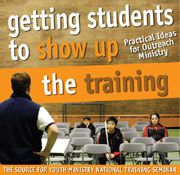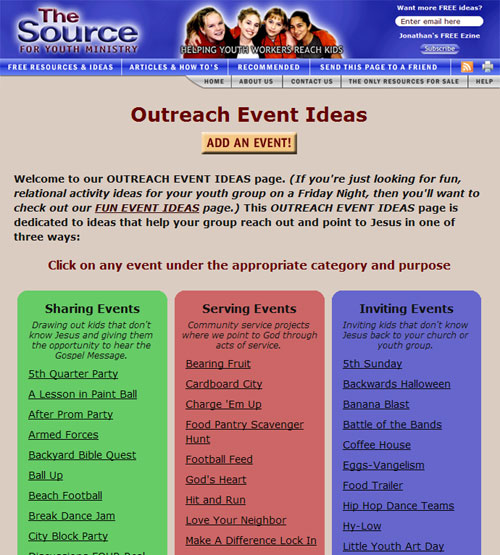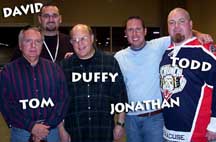| TheSource4YM.com | |
 |
Jonathan’s Resource Ezine |
Weekly Resources, Ideas and Articles from The Source for Youth Ministry
Wednesday, January 16, 2008
| In This Issue |
- Featured Article: Pointing to Jesus… on Purpose: Three Broad Categories of Outreach Events
- What’s New: Looking for Outreach Ideas? Try Our Brand New Outreach Event Ideas Page!
- New Podcast: Hear from Duffy Robbins, Jonathan, and the Whole Crew about Speaking to Teenagers
- Coming Soon: A Ready-made Super Bowl Party Quiz
| If you aren’t a subscriber of this EZINE and would like to subscribe – it’s free – just pop on www.TheSource4YM.com and sign up in the upper right hand corner. |
| Featured Article: Pointing to Jesus… on Purpose: Three Broad Categories of Outreach Events |
In celebration of our new OUTREACH EVENT IDEAS page, we are bringing you an exclusive excerpt from Jonathan’s new book Getting Students to Show Up. Enjoy Chapter 3 of this book below, an insight into the three broad categories of outreach events that you can use to make an impact.
Pointing Where We Want to Point
By Jonathan McKee
Why are you doing this event?
“To offer Christians some good clean entertainment.”
“To bring out people who don’t know Jesus and share the gospel with them.”
“To challenge our leaders to share their faith.”
These purposes for doing an event all seem noble, but very different.
So what’s the problem?
All of these responses were from different people describing the same two-hour event. They just didn’t know why they were doing the event.
That’s why I often ask youth leaders questions such as, “Why did you put on your last event?” or “What was the purpose of your last program?”
The first question I ask youth leaders when they ask me to speak is, “What is the purpose of this event?” If a youth leader wants me to speak during her weekly Wednesday night program, the first question I ask is, “Why do you do this Wednesday night program?”
And often the answer is, “Because we’ve always had a Wednesday night program!” How many times have you heard this response?
Sorry. “Because we’ve always done it that way” is not the purpose of a program.
Before we embark on any event planning, we should always know our destination. In this book we’re specifically talking about planning outreach programs. So for our purposes, let’s return to our definition of the outreach program:
activity, or program used as a means to
attract those who don’t know Jesus and
point them to Jesus.
As we discussed in chapter 2, our purpose for any outreach program will be to point them to Jesus. This isn’t debatable. By our own definition, the reason we’re planning a program at all is so we can point people to Jesus.
That’s our focus. Everything we do needs to aim for that goal. We need to be careful not to let any of our methodology interfere with this purpose. In other words, don’t let the activities drag on so long that we don’t have time to point them to Jesus, the very thing we set out to do!
I’ll never forget the group that planned a huge event with a carnival of fun activities, and a dynamic program with music, drama, and a speaker. Their programming was so involved, in fact, that they simply ran out of time. They were actually 10 minutes away from introducing the speaker when the facility started closing down and everyone had to leave.
They forgot their purpose.
Our goal is to point them to Jesus. Don’t let anything else get in the way of that.
But does pointing them to Jesus mean you have to have someone stand up and share the gospel at every event? Is that the only way to do an outreach program? Is that all that Jesus modeled? After every miracle did he whip out an easel and draw two cliffs and a cross bridging the gap?
The fact is we can point people to Jesus in numerous ways. I’ve narrowed them down to three broad categories.
A. Share the Gospel
This is a no-brainer. Create opportunities to share Christ with students once we get them out to our programs, activities, or events. We can do this with a speaker, movie, drama, or even music. I share the gospel at almost 80 percent of my outreach events or programs.
However, we shouldn’t plan on just sharing the message, shutting out the lights, and leaving. We need to give them an opportunity to respond. We should have a plan for talking with the people individually and creating a means for follow up. I usually have them raise a hand or come forward to meet with a counselor who can talk with them about the decision they made. I also use decision cards. If students meet with counselors, I have counselors fill out the cards for them- legibility is very important-noting their contact information, what decision they made (first-time decision, rededication, and so on), and what group, if any, they came with. These cards are vital and provide the groundwork for follow up.
Billy Graham’s organization has been doing a fantastic job with this for decades. Billy doesn’t just come to a city, preach, and leave. His organization comes a year in advance, training counselors, meeting with hundreds of area churches, and implementing a plan for following up with all the new believers. What an incredible example of faith and diligence. It’s a year before the invitation is even given; yet they’re planning for thousands to come forward. Faith and elbow grease working hand in hand.
On the night of a Billy Graham Crusade, those who come forward meet with counselors and hear the gospel one-on-one. Then they have an opportunity to make a decision. Everyone who comes forward then fills out a follow-up card. This is a great way to clarify the commitment they’ve made, and it sets the stage for following up with the person effectively.
Billy Graham’s organization shares the gospel responsibly. Don’t be afraid to mimic their methodology. We’ll look at more examples of how to (and how not to) share the gospel and give an invitation later in this book.
B. Demonstrate God’s Love with an Act of Service
Do you have to share the gospel to point to Jesus? Or consider this question: Was Mother Theresa a great evangelist?
Our actions often point to Jesus more effectively than our words do. The most famous “evangelism” passages in the Bible seem to talk more about actions than words. Think about it: God wants us to be salt and light in our world-“In the same way, let your light shine before men, that they may see your good deeds and praise your Father in heaven” (Matthew 5:16, emphasis mine).
Or how about 1 Peter 3:15-“Always be prepared to give an answer to everyone who asks you to give the reason for the hope that you have” (emphasis mine). Some people like to emphasize the part of this verse that says, “Always be prepared.” So we memorize four laws and go looking for people to share them with. Except-that’s not what the verse says. Look carefully. According to the verse, we need to have “the hope” in our lives. People need to notice something different about us. When the world is crumbling, they’ll see “the hope” in our lives. And just maybe they’ll ask us, “Hey, everything stinks right now, but you still seem to have hope. Why? What’s the reason for this hope?”
Now read the verse one more time: “Always be prepared to give an answer to everyone who asks you to give the reason for the hope that you have.” We can have “the hope.” We can show “good deeds” and point people to Jesus.
Believe it or not, demonstrating God’s love can be the purpose of an event-the type of event where people see Jesus through the example of his followers. The gospel doesn’t have to be shared because Christ is exemplified through the actions of his people. Your words are only half as important as your actions. No matter what “draw” you choose, make sure everyone involved knows the purpose of this event is serving selflessly so others can see God in your actions.
A few years back, our ministry had a contest where youth ministers from around the world submitted ideas for “out of the box” outreach-creative outreach ideas they’d successfully used with their own groups. I’ll never forget one idea that a youth pastor named Marty from Centerville, Ohio submitted:
I love Marty’s example. They didn’t set up easels in living rooms or drop off gospel tracts. They just met a need. Meeting needs and offering to pray for people created opportunities for conversation. And yes, 1 Peter 3:15 notes that we need to be ready for these opportunities. Just don’t force them. If people notice the “hope” in us and ask us about it, then we need to be ready to answer them. But it all starts by just demonstrating his love.
Other examples of events or programs where we demonstrate his love might be service projects, feeding the homeless, or even providing free goods or services in his name.
C. Invite Them to Church or Youth Group
Another way we can point people toward Jesus is by inviting them to hear more about Jesus. Yet, we don’t actually have to share everything the first time we meet someone. We can just invite them to come back.
If there’s one thing I’ve learned about evangelism in the new millennium-it’s much more about conversations than presentations. And good conversations take time.
Our events can simply have the purpose of inviting them back. Why do we feel as though we have to do it all in one night? The whole goal of an event could be to just show them a fun time and invite them back.
The church around the corner recently hosted a junior high event called “Pizza Feed.” Their youth group of about 30 students put on an event in the church gym, and every kid was encouraged to bring friends. The leaders and the students worked hard, and almost 100 teenagers showed up. They ate pizza, beat each other up in an inflatable boxing ring, laughed, hung out, and just had a good time. Ten minutes before the event was scheduled to end, they pulled everyone together, and then the staff did a funny skit, they announced their upcoming activities and trips, and a student from the youth group briefly shared about his life. He talked about some problems he’d experienced the previous year and how through this youth group he’d found people to talk to and answers to some of life’s questions. During this part of the event, Jesus was mentioned, but no invitation was given. Then the youth leader handed out flyers inviting everyone back for the next week.
What was the purpose of this event? Was it outreach?
Yes. Remember our definition of outreach program? This youth group invited teenagers who didn’t know Jesus with the draw of pizza. Then they pointed them to Jesus by giving them a glimpse of a place where they could go and find out more about him. The purpose of the event was to reach out to students who don’t go to church and simply invite them to church.
Not bad, huh?
Other inviting events could be carnivals, car shows, picnics, or even acts of community service where an “invite” to church is given.
The Need for Purpose
Don’t get caught planning an event without first knowing your goal or purpose. If you want to plan an outreach event, you must first decide what your goal will be. Do you want to share the gospel? Do you want to show Christ’s love with an act of service? Or maybe you just want to invite people to church. Regardless of which one you choose, in the planning of any event, you need to determine your purpose.
Even so, the purpose won’t necessarily get students to come to the event. So how can we draw them in?
I’m so glad you asked.
Let’s talk about that in the next chapter…
 If you enjoyed this article,
If you enjoyed this article,you may enjoy the training.
Consider bringing this
training to your city!
| What’s New: Looking for Outreach Ideas? Try Our Brand New Outreach Event Ideas Page! |
We’ve got a resource for you!
Check out our new OUTREACH EVENT IDEAS page.
If you’re looking for some ideas of how to reach out to your community with an activity, program or event, making an impact for Jesus, then take a peek at our OUTREACH EVENT IDEAS page. This page is dedicated to ideas that help your ministry reach out and point to Jesus in one of three ways:
- Sharing Events: Drawing out kids that don’t know Jesus and giving them the opportunity to hear the Gospel Message
- Serving Events: Community service projects where we point to God through acts of service
- Inviting Events: Inviting kids that don’t know Jesus back to your church or youth group.
This brand new page looks like this:

Take a peek for yourself to see the entire page!
| New Podcast: Hear from Duffy Robbins, Jonathan, and the Whole Crew about Speaking to Teenagers |
EPISODE #10
Featuring Duffy Robbins

THE SOURCE4YM PODCAST, EPISODE #10
JONATHAN: We’re so excited to have Duffy with us. Duffy, as you know, just co-authored a book with Doug Fields called…
DUFFY: Speaking to Teenagers.
JONATHAN: And we’re excited about it. Today, Duffy’s gonna share with us a little about how NOT to speak to teenagers. Duffy we’re excited you’re here.
DUFFY: Yeah, you know. It’s really something when you ask somebody to come in and share about how to do something. When you want to know how to do something, you ask somebody else. When you want to know how NOT to do something, you call me in.
(laughter from the crew)
JONATHAN: It’s a real confidence booster, huh?
DUFFY: Yeah, it’s perfect. I’m well suited for this task.
JONATHAN: So, Duffy, what are the 7 sins of speaking to teenagers?
DUFFY: I think sin #1 is assuming that all I need to do is think about the message, and not think about either the audience or myself.
JONATHAN: Sure.
DUFFY: It’s the ethical dimension. We must give adequate preparation, not just to our talk, but to our own heart. One of the things we know about audiences based on research in communication is that audiences want to know, “Are you passionate about what you are talking about? Are you competent to talk about this to me? Do you know what you are talkin’ about?”
JONATHAN: Wow. DUFFY: Sin #2 is not understanding that communication is NOT about what we say, it’s about what they hear. This truth makes all the difference. I give an example in the book about a missionary in residence at a camp I was at one summer in Maine. During the mission moment of the day, he was talking about all of the rain that the tropical region of Brazil experienced. He said, “We would never think about going out in this kind of rain without our rubbers on.”
JONATHAN: That’s a generational thing.
DUFFY: Yeah. You know, from his standpoint, of course he knows what he’s saying…but that’s not what they’re hearing.
JONATHAN: That’s right. That’s NOT what kids are hearing!
DUFFY: So the end result was something like 30 kids who wanted to go to Brazil! No seriously, although it did wonders for his recruitment to missions, I don’t doubt his heart nor his ability at all; he knows what he’s talking about. But what he has not given adequate attention to is his audience with whom he hopes to communicate. So that’s sin #2, not paying attention to who you’re talking to. What are their needs? What are their questions? It doesn’t do any good to scratch unless you know where they itch.
You will need to download it for free on iTunes
Episode Highlights:
- David R. Smith shares about what kids age 13-29 think of “Christians” and some of the similarities & differences between believers & unbelievers.
- Duffy makes everyone laugh as he shares the “Seven Sins of Speaking to Teenagers.” This hilarious time with Duffy is sure to help you enhance your ability to communicate God’s love to your teens.
- After Jonathan gets on Todd’s case for his cell phone going off during the recording, Jonathan’s phone goes off!
- Jonathan and the gang cover several questions from youth workers in our “Help Me” section.
- Jonathan exemplifies one of Duffy’s sins by plucking from the “low hanging fruit on the humor tree.”
- Tom shares a “Resource Highlight” from our Logistical Crud page that helped his church recently.
(CLICK HERE)
CLICK HERE FOR OUR PODCAST PAGE
| Coming Soon: A Ready-made Super Bowl Party Quiz |
 In the U.S., we are pretty fanatical about our Super Bowl. This televised event is a great excuse for social gatherings across the country so we like to encourage those of you in youth ministry to cash in on this great event opportunity.
In the U.S., we are pretty fanatical about our Super Bowl. This televised event is a great excuse for social gatherings across the country so we like to encourage those of you in youth ministry to cash in on this great event opportunity.
Each year we provide a “ready-made” Super Bowl event idea that you can use during this time. To make your Super Bowl party even more fun, we provide a ready-made quiz (coming a couple weeks before the big game) that we provide as a fun “event activity.” (CLICK HERE for last year’s quiz.)
Youth Groups have used this activity for years as a great event for fun and fellowship.
Last year some of you might remember reading in the news about a large church that was planning a big Super Bowl party showing the big game on the big screen at their church. They were shut down because of the disclaimer at the beginning of the game that prohibits public showing of the game.
WE WANT YOUR FEEDBACK:
- Is the age old “Super Bowl party” a violation of that “disclaimer?”
- Does anyone know the actual law when it comes to this?
- What’s the difference between having 10 friends over in your living room and having 10 kids from your youth group over?
- Is the problem only when you host a big event at a church or school, or charge money, or are all Super Bowl gatherings illegal? (and if so… how come every Super Bowl commercial shows a bunch of people in a living room watching a game together?)
- Is this the most ridiculous thing you’ve ever heard?
Delivered free via e-mail to subscribers each week. We encourage you to distribute this newsletter freely and ask only that you not change its contents.
HAVE YOU MISSED PAST “EZINE” ARTICLES?
CLICK HERE FOR JONATHAN’S “EZINE” ARCHIVES
And for more FREE resources and ideas … go to THE SOURCE
www.TheSource4YM.com
Copyright ?2008 The Source for Youth Ministry
All rights reserved.
Jonathan McKee
Jonathan McKee is the author of over twenty books including the brand new The Guy's Guide to FOUR BATTLES Every Young Man Must Face; The Teen’s Guide to Social Media & Mobile Devices; If I Had a Parenting Do Over; and the Amazon Best Seller - The Guy's Guide to God, Girls and the Phone in Your Pocket. He speaks to parents and leaders worldwide, all while providing free resources for youth workers on TheSource4YM.com. Jonathan, his wife Lori, and their three kids live in California.
